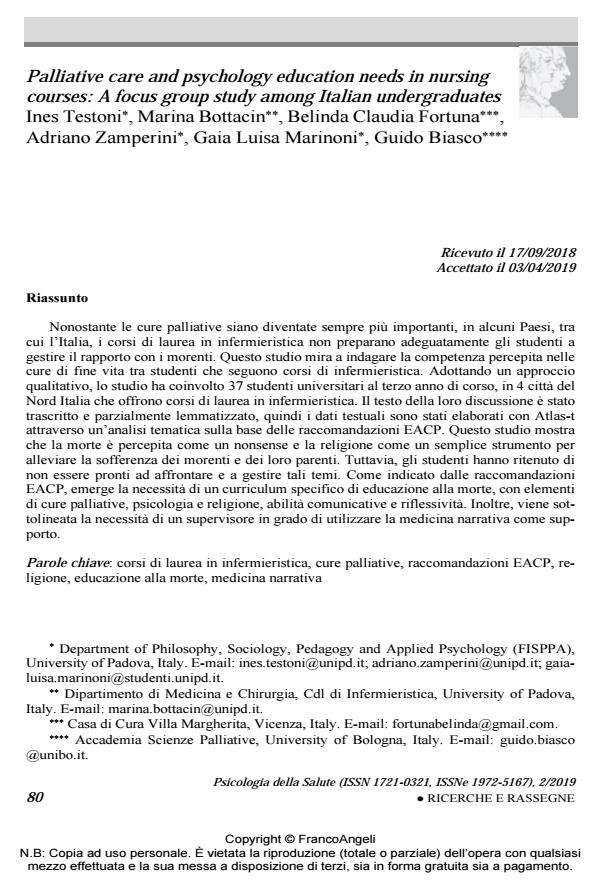Palliative care and psychology education needs in nursing courses: A focus group study among Italian undergraduates
Titolo Rivista PSICOLOGIA DELLA SALUTE
Autori/Curatori Ines Testoni, Marina Bottacin, Belinda Claudia Fortuna, Adriano Zamperini, Gaia Luisa Marinoni, Guido Biasco
Anno di pubblicazione 2019 Fascicolo 2019/2
Lingua Inglese Numero pagine 20 P. 80-99 Dimensione file 281 KB
DOI 10.3280/PDS2019-002004
Il DOI è il codice a barre della proprietà intellettuale: per saperne di più
clicca qui
Qui sotto puoi vedere in anteprima la prima pagina di questo articolo.
Se questo articolo ti interessa, lo puoi acquistare (e scaricare in formato pdf) seguendo le facili indicazioni per acquistare il download credit. Acquista Download Credits per scaricare questo Articolo in formato PDF

FrancoAngeli è membro della Publishers International Linking Association, Inc (PILA)associazione indipendente e non profit per facilitare (attraverso i servizi tecnologici implementati da CrossRef.org) l’accesso degli studiosi ai contenuti digitali nelle pubblicazioni professionali e scientifiche
Nonostante le cure palliative siano diventate sempre più importanti, in alcuni Paesi, tra cui l’Italia, i corsi di laurea in infermieristica non preparano adeguatamente gli studenti a gestire il rapporto con i morenti. Questo studio mira a indagare la competenza percepita nelle cure di fine vita tra studenti che seguono corsi di infermieristica. Adottando un approccio qualitativo, lo studio ha coinvolto 37 studenti universitari al terzo anno di corso, in 4 città del Nord Italia che offrono corsi di laurea in infermieristica. Il testo della loro discussione è stato trascritto e parzialmente lemmatizzato, quindi i dati testuali sono stati elaborati con Atlas-t attraverso un’analisi tematica sulla base delle raccomandazioni EACP. Questo studio mostra che la morte è percepita come un nonsense e la religione come un semplice strumento per alleviare la soffe-renza dei morenti e dei loro parenti. Tuttavia, gli studenti hanno ritenuto di non essere pronti ad affrontare e a gestire tali temi. Come indicato dalle raccomandazioni EACP, emerge la necessi-tà di un curriculum specifico di educazione alla morte, con elementi di cure palliative, psicolo-gia e religione, abilità comunicative e riflessività. Inoltre, viene sottolineata la necessità di un supervisore in grado di utilizzare la medicina narrativa come supporto.
Parole chiave:Corsi di laurea in infermieristica, cure palliative, raccomandazioni EACP, reli-gione, educazione alla morte, medicina narrativa
- Students’ Confidence and Interest in Palliative and Bereavement Care: A European Study Hod Orkibi, Gianmarco Biancalani, Mihaela Dana Bucuţã, Raluca Sassu, Michael Alexander Wieser, Luca Franchini, Melania Raccichini, Bracha Azoulay, Krzysztof Mariusz Ciepliñski, Alexandra Leitner, Silvia Varani, Ines Testoni, in Frontiers in Psychology 616526/2021
DOI: 10.3389/fpsyg.2021.616526 - Death education: the importance of terror management theory and of the active methods Ines Testoni, in Evidence Based Nursing /2024 pp.72
DOI: 10.1136/ebnurs-2023-103774 - Impact of Teaching Palliative Psychology with Psychodrama and Arts Therapies on Psychology Students in Klagenfurt Michael Alexander Wieser, Alexandra Leitner, in Behavioral Sciences /2023 pp.931
DOI: 10.3390/bs13110931 - Psychology Students' Perceptions of COVID-19 in a Death Education Course Ines Testoni, Erika Iacona, Cecilia Corso, Sara Pompele, Laura Dal Corso, Hod Orkibi, Michael Alexander Wieser, in Frontiers in Public Health 625756/2021
DOI: 10.3389/fpubh.2021.625756 - The Role of Family Physicians in Older People Care Ines Testoni, Simone Cernesi, Federica Davolio, Marta Perin, Mariagiovanna Amoroso, Chiara Villani, Jacopo Demurtas, pp.407 (ISBN:978-3-030-78922-0)
- Facing COVID-19 Between Sensory and Psychoemotional Stress, and Instrumental Deprivation: A Qualitative Study of Unmanageable Critical Incidents With Doctors and Nurses in Two Hospitals in Northern Italy Ines Testoni, Chiara Franco, Enrica Gallo Stampino, Erika Iacona, Robert Crupi, Claudio Pagano, in Frontiers in Psychology 622894/2021
DOI: 10.3389/fpsyg.2021.622894 - Committing to arts-based palliative and bereavement care: Evaluation of students’ experiences in an online course Hod Orkibi, Shoshi Keisari, Bracha Azoulay, Ines Testoni, in The Arts in Psychotherapy 102064/2023 pp.102064
DOI: 10.1016/j.aip.2023.102064 - Interest and Confidence in Death Education and Palliative Psychology in Italian and Indian University Students of Psychology: Similarities and Differences Gianmarco Biancalani, Rekha Wagani, Lucia Ronconi, Matteo Cornacchini, Ines Testoni, in Behavioral Sciences /2023 pp.183
DOI: 10.3390/bs13020183 - A Challenge for Palliative Psychology: Freedom of Choice at the End of Life among the Attitudes of Physicians and Nurses Ines Testoni, Camilla Bortolotti, Sara Pompele, Lucia Ronconi, Gloria Baracco, Hod Orkibi, in Behavioral Sciences /2020 pp.160
DOI: 10.3390/bs10100160
Ines Testoni, Marina Bottacin, Belinda Claudia Fortuna, Adriano Zamperini, Gaia Luisa Marinoni, Guido Biasco, Palliative care and psychology education needs in nursing courses: A focus group study among Italian undergraduates in "PSICOLOGIA DELLA SALUTE" 2/2019, pp 80-99, DOI: 10.3280/PDS2019-002004